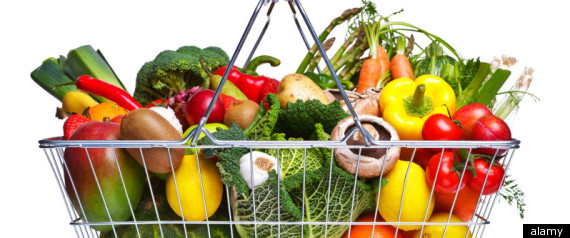The Department of Health, the NHS and the British Dietetic
Association all recommend five portions of fruit and vegetables per day
combined. For many people this seems impossible, for other this is too little,
so just what is a portion size and where does this recommendation come from?
Well here is some quick guidance as to what can be ‘qualified’ as one of your
five a day.
·
Fresh fruit and vegetables, in
dishes or on the side
·
Frozen fruit and vegetables,
in dishes or on the side
·
Tinned or canned fruit and
vegetables. Where possible buy the ones tinned in natural juice or water, with
no added salt, sugar or syrup.
·
Dried fruit, such as sultanas,
currants, dates, cranberries and figs.
·
A 150ml glass of unsweetened
100% fruit or vegetable juice, counts as one of your five a day, but can only
be counted once a day.
·
Smoothies! Smoothies count as
up to a maximum of two portions per day, provided that they are made with all
of the edible parts of the fruit and not just the juice.
·
Beans and pulses. Despite
being a great source of protein, these only count as one portion a day, no
matter how many you eat. This is because they contain fewer vitamins and
minerals than other fruits and vegetables.
·
Fruit and vegetables in
convenience foods, such as ready meals and shop-bought pasta sauces, soups and
puddings. However, many convenience foods are high in salt, sugar and fat, so
try to use them as a last resort and stick to home cooking where possible.
·
Sweet potatoes, swedes and
parsnips do count towards your five a day, but potatoes, yams, plantains and
cassavas do not, however they do provide as great sources of carbohydrates – so
don’t leave them off the plate!
Taken from the NHS website, here is a guide of what
constitutes a portions size of common fruits or vegetables. However a good
rough guideline to follow and an easy one to remember is each portion,
compressed, should be about the size of a clenched fist.
Fruit portions
·
Small-sized
fresh fruit - One portion is two or more small fruit, for example two plums, two
Satsumas, two kiwi fruit, three apricots, six lychees, seven strawberries or 14
cherries.
·
Medium-sized
fresh fruit - One portion is one piece of fruit, such as one apple, banana, pear,
orange, nectarine or Sharon fruit.
·
Large
fresh fruit - One portion is half a grapefruit, one slice of papaya, one slice of
melon (5cm slice), one large slice of pineapple or two slices of mango (5cm
slices).
·
Dried
fruit - A portion of dried fruit is around 30g. This is about one heaped
tablespoon of raisins, currants or sultanas, one tablespoon of mixed fruit, two
figs, three prunes or one handful of dried banana chips.
·
Tinned
fruit in natural juice - One portion is roughly the
same quantity of fruit that you would eat for a fresh portion, such as two pear
or peach halves, six apricot halves or eight segments of tinned grapefruit.
Vegetable portions
·
Green
vegetables - Two broccoli spears or four heaped tablespoons of kale, spinach, spring
greens or green beans.
·
Cooked
vegetables - Three heaped tablespoons of cooked vegetables, such as carrots, peas or
sweet corn, or eight cauliflower florets.
·
Salad
vegetables - Three sticks of celery, a 5cm piece of cucumber, one medium tomato or
seven cherry tomatoes.
·
Tinned
and frozen vegetables - Roughly the same quantity as
you would eat for a fresh portion. For example, three heaped tablespoons of
tinned or frozen carrots, peas or sweet corn.
·
Pulses
and beans - Three heaped tablespoons of baked beans, haricot beans, kidney beans,
cannellini beans, butter beans or chickpeas. However much you eat, beans and
pulses count as a maximum of one portion a day.
The five portions of fruit and vegetables per day
are recommended based on a varied diet, as a rough guideline to meet your daily
vitamin, mineral and fibre requirements. Have a look back through some of my
other postings for more information on the benefits of certain fruits and
vegetables in relation to diseases prevention. So how many are you getting in
each day?
Here are a few tips on how to get a few more
portions into yours and your family’s diet to increase their dietary intake and
instil some good habits to get into:
Breakfast – add dried fruit to cereal, and fresh fruit
juices to the table. If having a breakfast smoothie, add in whole fruit, and
even small portions of vegetables such as raw cabbage, cucumber or spinach. It
won’t ruin the flavour, but will add in some more vitamins and minerals and
increase its fibre content.
Lunch and Dinner – Add chickpeas, lentils and left over veg to stews
and other dishes. If you have a picky family, pop all the veg in a food
processor and then stir into the sauce to disguise, or top steamed vegetables
with sauces to encourage their consumption.
Snacks – Make pre-prepared snacks that include chopped fresh
fruit to pick at with a squeeze of lemon juice to stop it from spoiling, and
chopped carrot, cucumber and celery sticks with a bit of hummus to encourage
their consumption.
Home baking – try experimenting, many tasty recipes add in
vegetables for depth of flavour and a little more health. Try parsnip cakes or
beetroot brownies as a starting point!



No comments:
Post a Comment